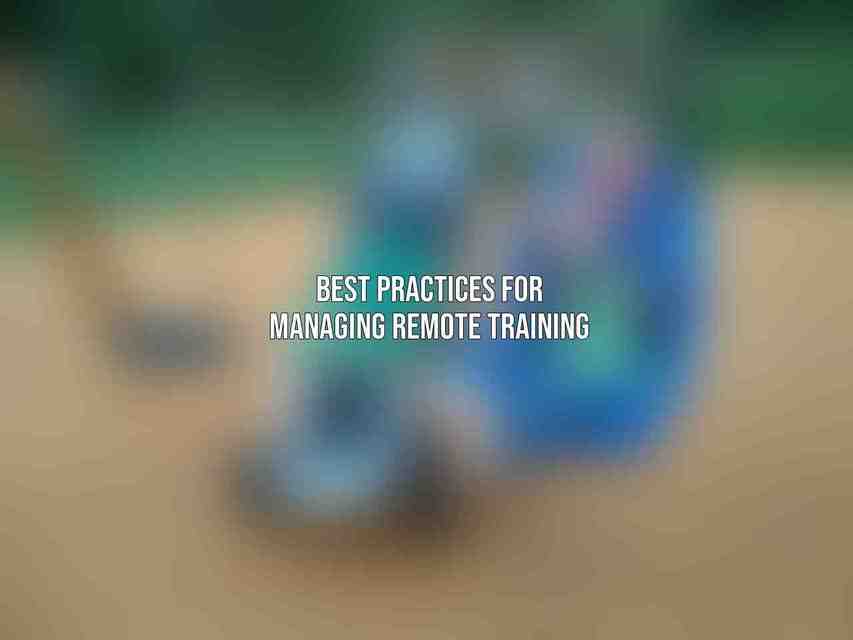the concept of remote teams has become increasingly prevalent. With the rise of telecommuting and globalized workforces, the need for effective training strategies for remote teams has never been more crucial. Training remote teams is not just an option; it is a necessity to ensure productivity, efficiency, and cohesion within the team. However, this form of training comes with its own set of challenges that need to be addressed to maximize its effectiveness.
Importance of Training Remote Teams
Training remote teams is essential for several reasons:
– Ensuring alignment: Remote teams need to be aligned with the organization’s goals, values, and practices just like any other team.
– Building relationships: Training fosters a sense of belonging and connection among team members who may never physically meet.
– Increasing productivity: Well-trained remote teams are more equipped to handle tasks independently and efficiently.
Challenges of Training Remotely
Training remote teams presents unique challenges such as:
– Lack of face-to-face interaction: Building rapport and trust can be more challenging in a remote setting.
– Communication barriers: Without physical cues, misinterpretations can easily occur.
– Technology issues: Connectivity problems can hinder the training process.
Communication Tools and Practices
Effective communication is the cornerstone of successful remote team training. Implementing the right tools and practices is key to overcoming the barriers posed by physical distance.
Communication Best Practices
To enhance communication within remote teams, consider the following best practices:1. Establish clear communication protocols: Ensure everyone understands how, when, and where to communicate.2. Utilize video conferencing effectively: Face-to-face interaction fosters better connections.3. Implement instant messaging and collaboration tools: Platforms like Slack and Microsoft Teams facilitate quick exchanges.4. Foster open and frequent communication: Encourage an environment where team members feel comfortable sharing ideas and feedback.5. Enact feedback mechanisms for continuous improvement: Regular feedback loops help in identifying areas for growth.
Top Remote Communication Tools
Utilizing the right communication tools can significantly improve remote team collaboration. Some top tools include:1. Zoom: Zoom offers a comprehensive video conferencing solution with features like breakout rooms and virtual backgrounds.2. Microsoft Teams: Microsoft Teams combines chat, video meetings, file storage, and app integration in one platform.3. Slack: Slack is known for its real-time messaging, file sharing, and integration capabilities.4. Asana: Asana is a project management tool that streamlines team collaboration and task management.5. Trello: Trello’s visual approach to project management makes it easy for remote teams to organize tasks and workflows.
Training Delivery Methods

Remote training can be delivered synchronously or asynchronously, each with its own advantages and considerations.
Synchronous Training
Synchronous training involves real-time interaction between trainers and trainees. Some common methods include:1. Live Webinars: Webinars allow for interactive presentations, Q&A sessions, and real-time engagement.2. Virtual Classrooms: Virtual classrooms replicate traditional learning environments with added flexibility.
Asynchronous Training
Asynchronous training allows learners to engage with materials at their own pace and time, popular methods include:1. Online Courses: Self-paced courses that provide flexibility in learning.2. Video Recordings: Recorded sessions that can be accessed anytime.3. Self-Study Materials: Texts, manuals, and resources that learners can explore independently.
Instructional Design for Remote Training
ensuring engagement and knowledge retention.
Design Principles for Effective Remote Training
When designing remote training programs, consider the following principles:1. Establish learning objectives: Clearly define what learners should be able to do after completing the training.2. Segment content into manageable chunks: Break down information into digestible sections for better understanding.3. Utilize interactive elements: Incorporate quizzes, polls, and discussions to engage learners.4. Provide practice opportunities: Hands-on activities that allow learners to apply new knowledge.5. Offer learner support: Provide resources and assistance for learners who may need extra help.
Best Practices for Remote Instructional Design
To enhance the effectiveness of remote training design, follow these best practices:1. Use engaging visuals and multimedia: Visual aids enhance learning and retention.2. Adapt content to different learning styles: Cater to various learning preferences to ensure inclusivity.3. Facilitate collaborative learning experiences: Encourage teamwork and peer interaction for a richer learning experience.4. Evaluate learning outcomes: Assess the effectiveness of the training through quizzes, surveys, and assessments.
Technology for Remote Training
Technology plays a significant role in enabling remote training experiences, offering platforms and tools designed for virtual learning environments.
Virtual Training Platforms
Consider utilizing virtual training platforms like:1. Adobe Connect: Adobe Connect offers virtual classrooms, webinars, and collaboration features.2. GoToTraining: GoToTraining provides interactive tools for virtual training sessions.3. Webex: Webex offers video conferencing, online meetings, webinars, and screen sharing capabilities.
LMS for Remote Training
Learning Management Systems (LMS) are essential for managing and delivering remote training content, consider:1. Moodle: Moodle is an open-source LMS with comprehensive features for course creation and management.2. Canvas: Canvas is a user-friendly LMS known for its customization and integration options.3. Blackboard: Blackboard offers a robust LMS with tools for course delivery, assessments, and collaboration.
Evaluation and Assessment
Evaluating remote training programs is crucial to measure effectiveness and make improvements for future initiatives.
Evaluation Methods for Remote Training
Consider using various evaluation methods such as:1. Online Quizzes: Assess knowledge retention and understanding through online quizzes.2. Performance Assessments: Measure the application of learned skills in real-world scenarios.3. Participant Feedback: Gather insights from participants on their training experience.
Best Practices for Evaluating Remote Training
Enhance the evaluation process by following these best practices:1. Set clear evaluation criteria: Define metrics for success and performance indicators.2. Gather feedback from multiple sources: Obtain feedback from trainers, participants, and stakeholders for a comprehensive perspective.3. Use data to improve training effectiveness: Analyze evaluation data to identify strengths, weaknesses, and areas for enhancement.
Best Practices for Managing Remote Training

Effective management of remote training programs involves establishing policies, providing support, and creating a conducive learning environment.
Establishing Training Policies and Procedures
Set clear guidelines on training expectations, schedules, and communication protocols to ensure consistency and clarity for all team members.
Providing Technical Support and Resources
Support remote trainees with technical assistance, access to resources, and troubleshooting guidance to overcome technology-related challenges.
Fostering a Positive Learning Environment
Create a supportive and inclusive atmosphere that encourages collaboration, knowledge sharing, and continuous learning among remote team members.
Monitoring and Evaluating Training Progress
Regularly monitor training progress, assess outcomes, and adjust strategies as needed to ensure continuous improvement and alignment with organizational goals.
effective training strategies for remote teams are vital for the success of modern organizations operating in a distributed workforce environment. By implementing best practices in communication, utilizing suitable training delivery methods, leveraging technology, and prioritizing evaluation and management, organizations can empower their remote teams for maximum productivity and engagement.
Key Takeaways for Effective Remote Team Training
- Establish clear communication protocols and utilize appropriate tools for seamless collaboration.
- Design training programs with engaging content, interactive elements, and support for diverse learning styles.
- Implement technology solutions like virtual training platforms and LMS for effective remote learning experiences.
- Regularly evaluate training programs, gather feedback, and use data to enhance training effectiveness.
Future Trends in Remote Training
As technology continues to advance, the future of remote training may see increased integration of artificial intelligence, virtual reality, and personalized learning experiences tailored to individual team members. Organizations that stay adaptable and embrace innovation in their remote training strategies will be better equipped to meet the evolving needs of remote teams in the years to come.
Frequently Asked Questions
What are some effective training strategies for remote teams?
Some effective training strategies for remote teams include utilizing video conferencing tools for virtual meetings and training sessions, creating interactive online modules for skill development, setting clear goals and expectations for team members, providing regular feedback and support, and fostering a sense of community and collaboration among team members.
